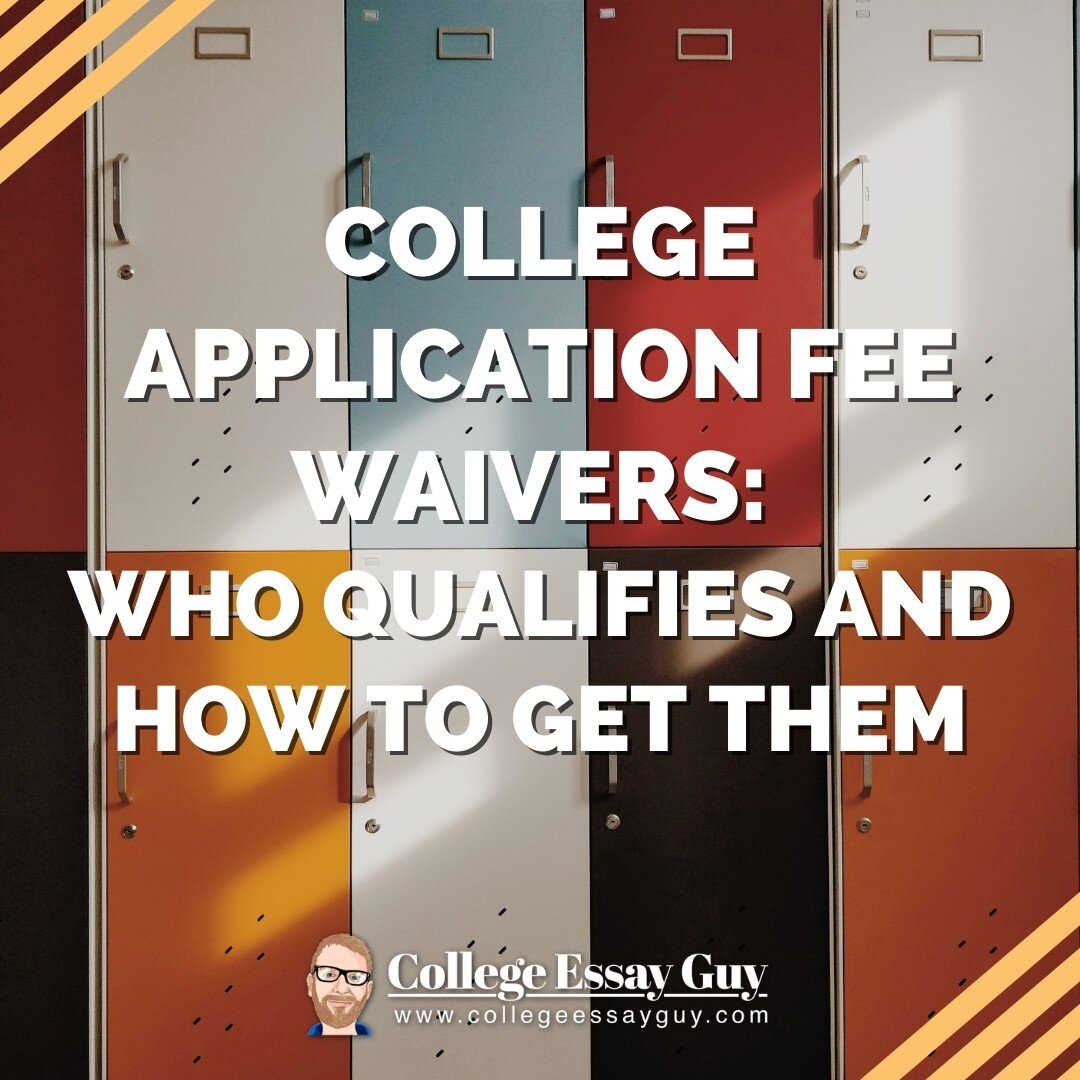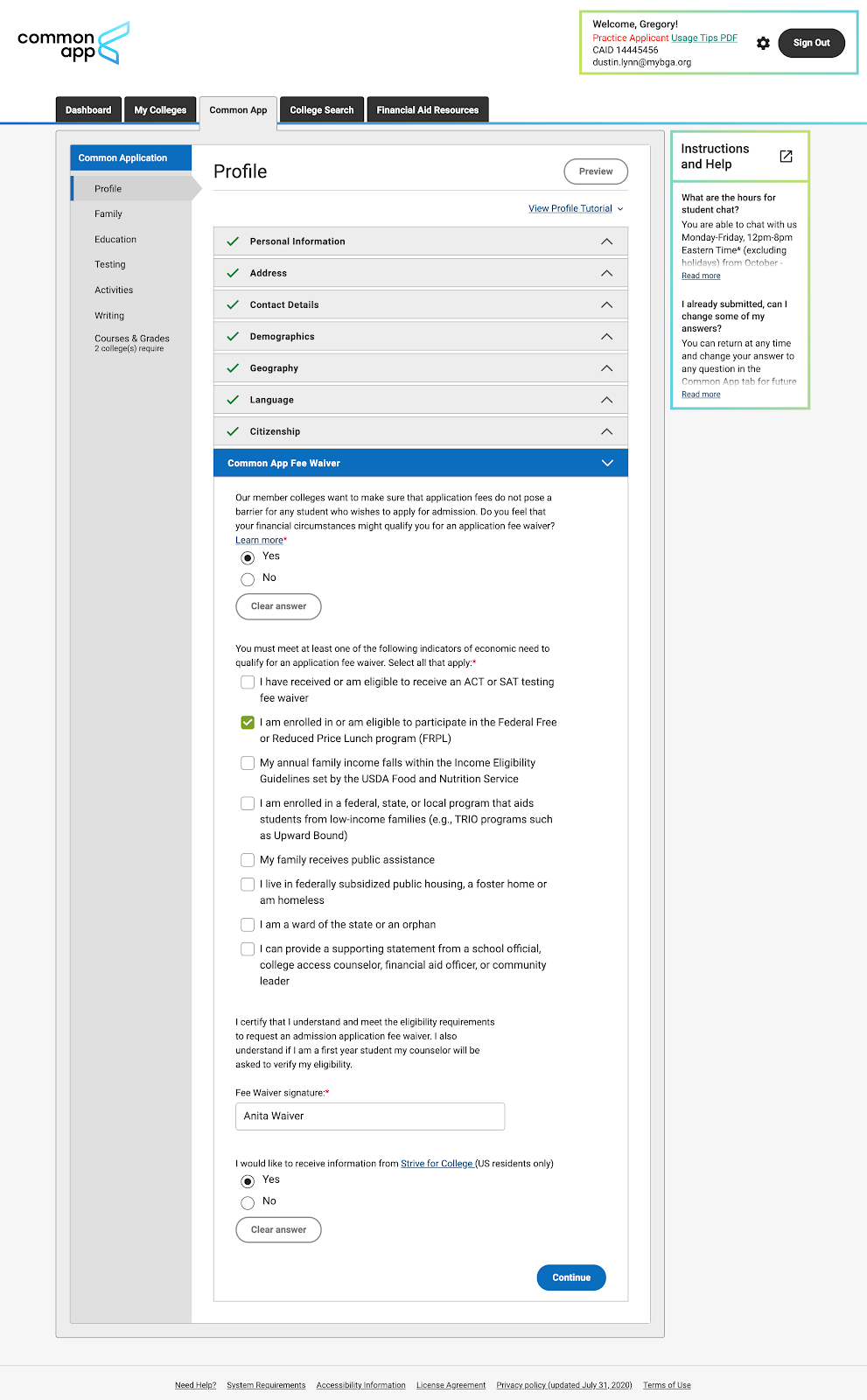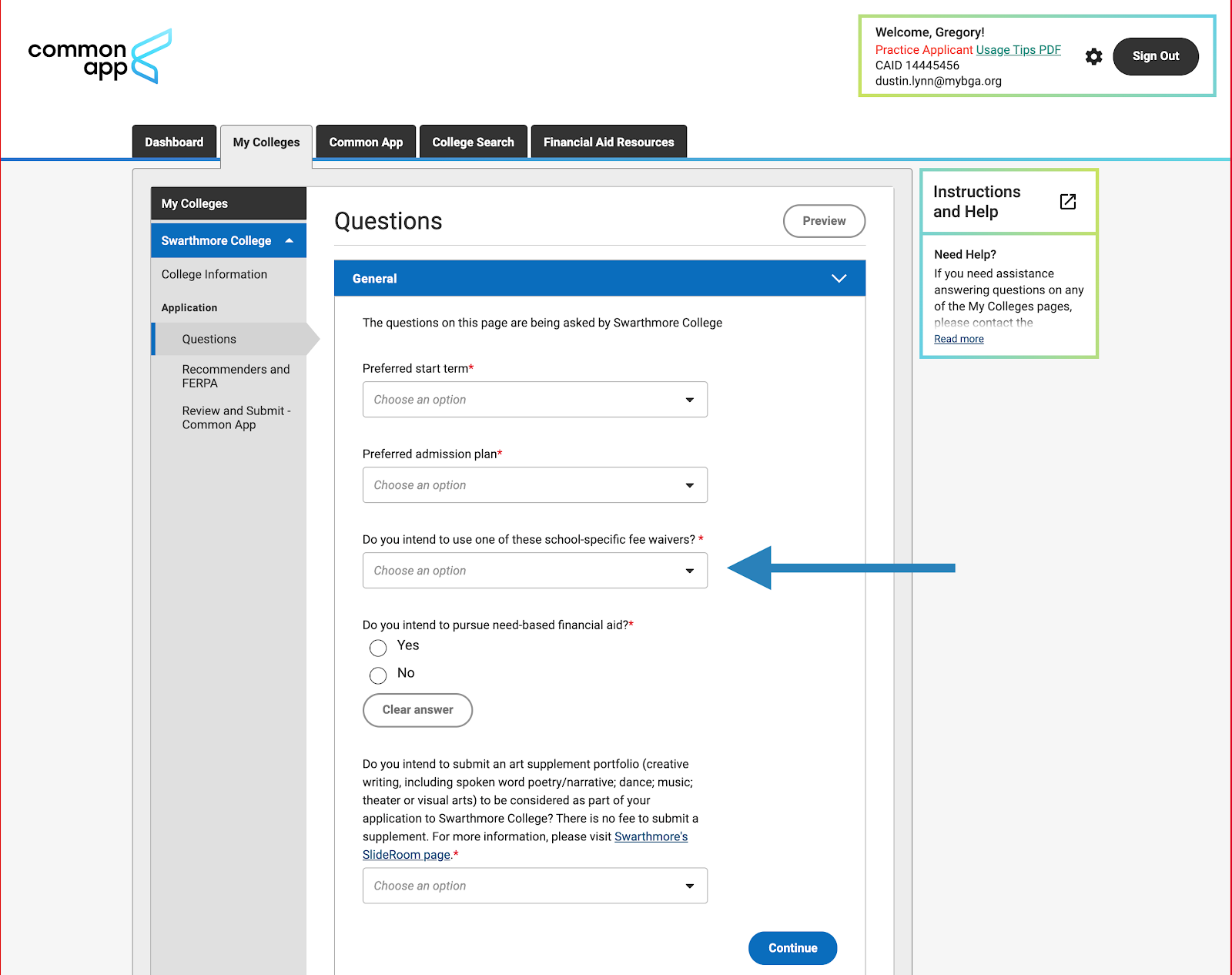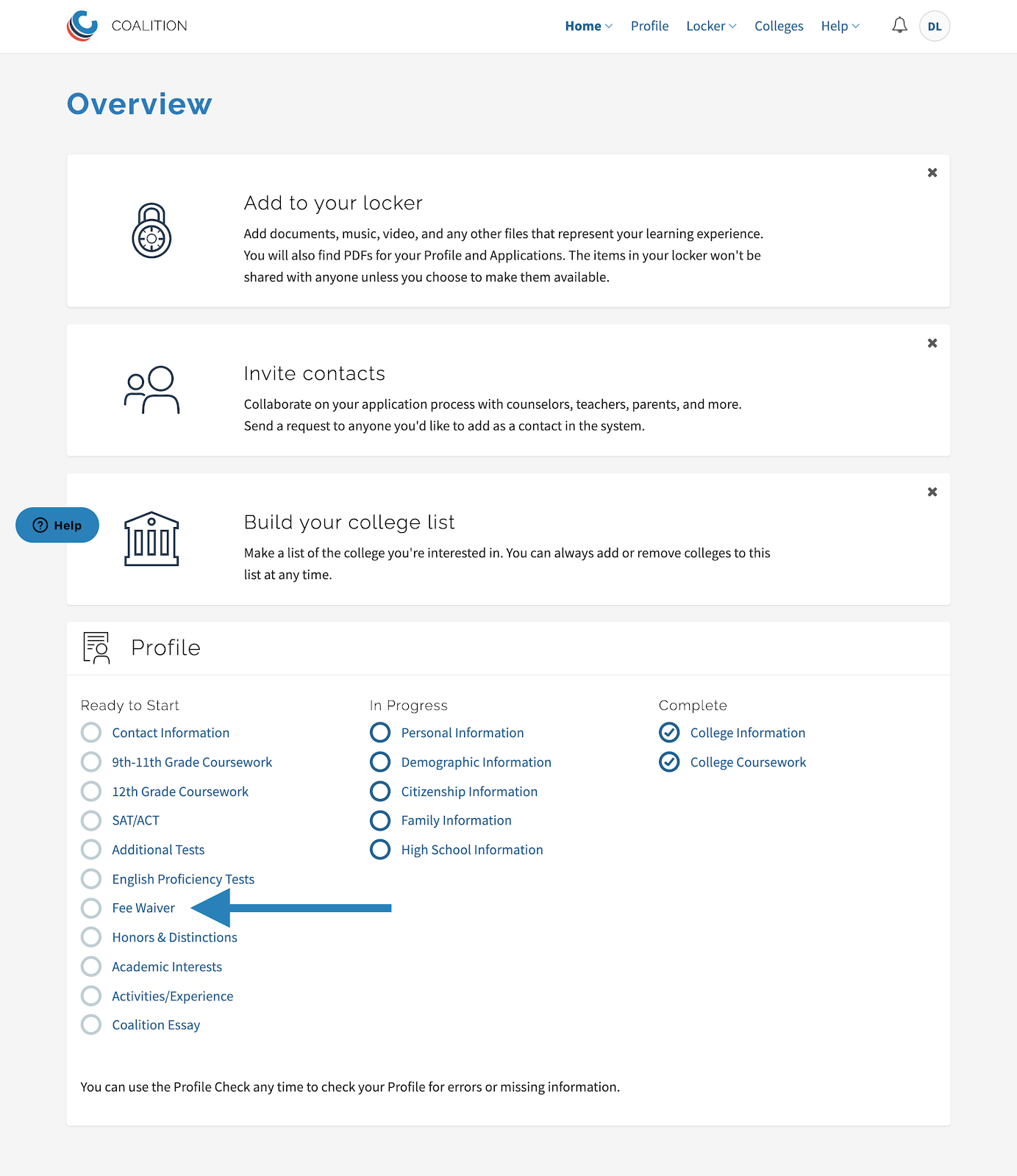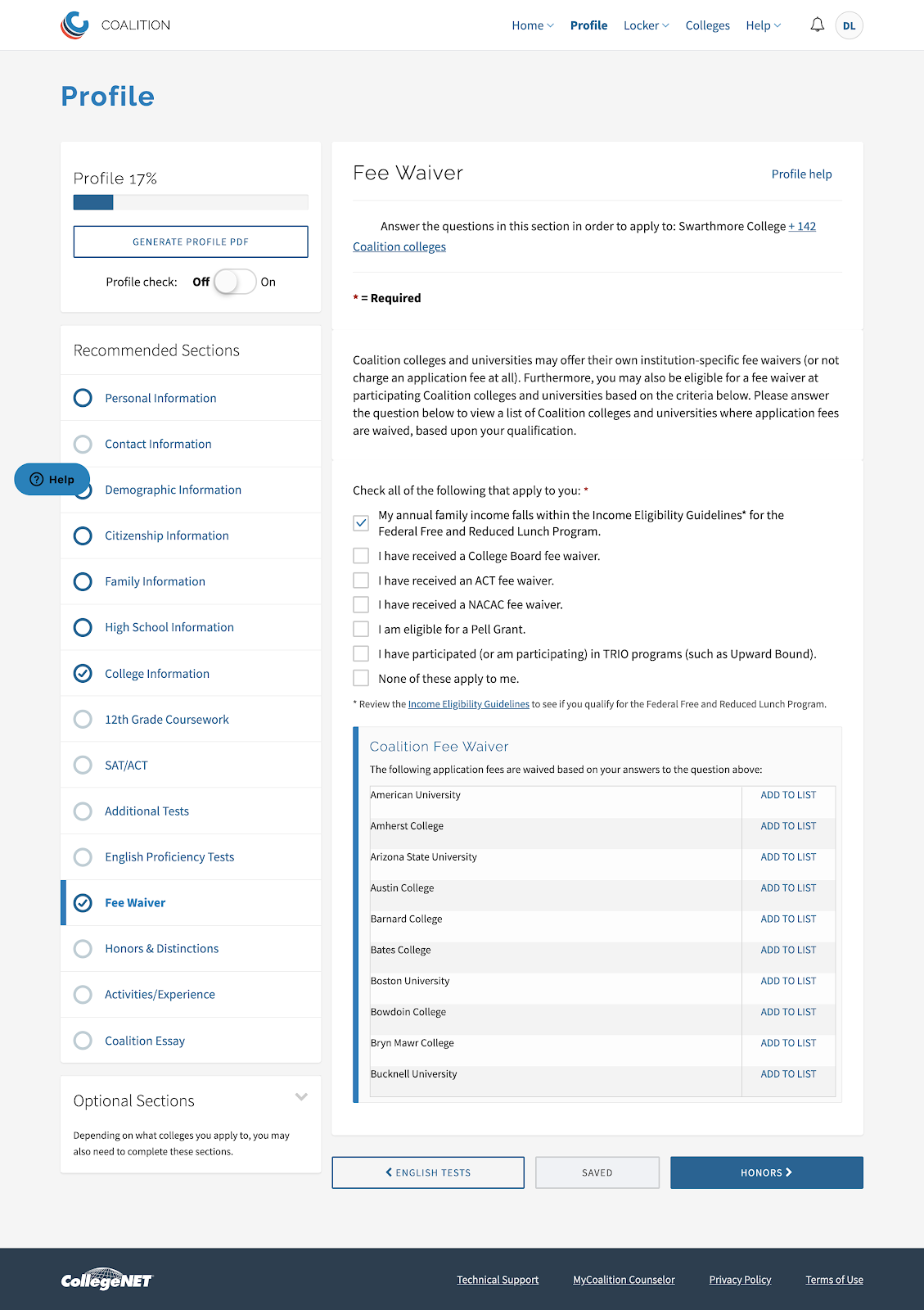Written by Dustin Lynn (Director of College Counseling at Battle Ground Academy in TN) and Andrew Moe (Director of Admissions at Swarthmore College in PA).
In this post, we’ll cover:
What is a college application fee waiver?
Who qualifies for college application fee waivers?
How to obtain and complete a fee waiver
Some last important tips about fee waivers (and life) in general
So you've just decided on the list of colleges you're applying to. You're working on your activities section and your personal statement, and you’ve started to look at a few supplemental essays. But as you get closer to submitting your application, you see it. The college application fee.
Students are often surprised to find that submitting their college applications typically requires a payment to the college or university. Some colleges allow students to apply for free, but other colleges charge students between $25 to $90 simply to submit their applications.
Pro Tip: Some colleges do NOT charge an application fee, or else they offer specific windows of time throughout the year when they waive their application fees. Check with your college to see if these types of opportunities are available and, if so, plan to submit your application to align with the free application timeline.
Additionally, the college application process is often accompanied by several financial surprises in the form of fees that students may not initially know about. Beyond the college application fee, students might have to pay matriculation or housing fees (which we’ll discuss a little later) or fees to have test scores sent to colleges from places like ACT and College Board.
As a result of these unanticipated costs, you might start seeing the dollar signs add up in your mind and you might feel worried.
But here’s the good news: If you and your family can’t afford the application fees, you can actually apply to college for free. This guide will show you how.
First things first:
What is a college application fee waiver?
A fee waiver is most typically a form that a student completes, on their own and/or with the help of a school counselor or high school official, then submits to a college or university to request that the application fee be “waived” – cancelled – removed! There are a few different forms of fee waivers, but most require students to demonstrate that the application fee presents a financial hardship for their ability to apply to the institution — emphasis here on presents a financial hardship. Of course, no one ever wants to pay fees, but waivers for college application fees are meant for students and families who otherwise would not be able to apply to college without financial assistance.
Note: There are other ways to receive an application fee waiver that are not dependent on a financial hardship that we won’t necessarily cover here. For example, some colleges may offer you a fee waiver for attending (even virtually) an admissions program. Sometimes colleges will email you out of the blue with an application fee waiver. When in doubt, you can always ask the admissions office.
Who qualifies for a fee waiver?
A student typically has to meet at least one of the following criteria to receive a fee waiver:
Receive or be eligible to receive free or reduced lunch at their high school
Family income falls within the income eligibility guidelines set by the USDA Food and Nutrition Service
Eligible for a fee waiver through the ACT or College Board
Receives public assistance, such as housing, food, or child care subsidies
Lives in a federally subsidized public housing, a foster home or is homeless
Enrolled in a federal, state, or local program that aids students from low-income families such as Upward Bound, Educational Talent Search or another TRiO program such as GEAR UP.
Veteran of the U.S. Armed Forces or on active duty in the U.S. military
Sometimes, though, a student might legitimately have difficulty paying for college but does not fall neatly into one of these categories. If none of these situations applies to you but you do not have the funds to apply to college, do not stop there! Most fee waivers give the option for the student to provide a supporting statement on their own or from a school official (such as a counselor or principal), college access advisor, financial aid officer, or community leader explaining their financial hardship.
Students usually need to pursue this option if one of their parents or guardians recently lost a job and suffered reduced family income, a family member passed away, unexpected expenses arise, COVID-19 presented unexpected expenses for your family, or any number of other reasons that impacted your family’s financial situation.
You think you qualify — now what?
How do you get a fee waiver?
Your next step often depends on which application you’ll use to apply to a college or university. There are several types of fee waivers, and we’ll discuss the most popular ones based on their associated college applications. Before you get started, though, just like with the application process, each college maintains its own process and requirements for requesting a fee waiver. While most colleges will likely accept the fee waivers that we’ll go over in a moment, some institutions have their own unique fee waiver process. Boise State, for example, does a great job of outlining the requirements for a fee waiver as well as providing information for requesting a fee waiver.
Pro Tip: Before proceeding with the fee waiver process, check out the admission websites for any colleges to which you’re applying to learn more about their respective requirements. You’ll typically find information related to fee waivers listed on their application requirements page (just like with our Boise State example). Some institutions (like Swarthmore College) have even created useful tools to help you determine if you qualify for a fee waiver and how you can obtain one. Also, Google is your friend! You can often find more information about a college’s fee waiver simply by Googling the college’s name and the words “application fee waiver.” If you don’t find the information you need or if it’s unclear, do not hesitate to reach out to a college’s office of admissions to speak with a representative to see if you qualify for a fee waiver and how you can submit a request for one.
Now, let’s save you and your family some money! The following are the various types of fee waivers available and how you can access and submit each of them:
The Common Application Fee Waiver
There are two main ways to request a fee waiver when using the Common Application. There’s the Common App Fee Waiver — and Common App has created a guide to help you understand their fee waiver process. To submit the request in your Common App, simply follow these steps:
In the “Profile” section of your Common App, click on the “Common Application Fee Waiver” subsection. If you’ve made it this far into this guide, you likely think that you might qualify for a fee waiver, so you should choose “Yes” to confirm that you believe you qualify for a fee waiver before selecting “Continue.” You’ll then be asked to select the supporting reason for your fee waiver and sign the request digitally. You’ll also have the opportunity to request additional application guidance from Strive for College if you’re interested.
After you complete these steps and click “Continue,” your school counselor or another school official you designated on the Common App will receive your request and will certify the form and sign it digitally.
There’s also what’s called a “school-specific fee waiver.” This question can be found on the Member Questions section of the Common Application. You’ll need to first add the college to your college list, and then you can proceed to their Member Questions. Here’s what it looks like on Swarthmore’s page of the Common App:
Keep in mind that not all colleges will use or offer a school-specific fee waiver, but you can check to see if you might qualify if this option is available for the colleges on your list. The drop down list might say, for example, that your fee is waived if you’re applying via QuestBridge, and if that’s the case, you can usually select that option. Again, you can always email or call the admissions office if you’re confused.
When you’re ready to submit your Common App, you’ll be asked to review and submit your application and to provide payment information — but you won’t be submitting a payment since you’re using a fee waiver. Check out this YouTube video from Common App to see how you’ll submit your application after submitting your fee waiver request.
Finally, we mentioned that some colleges don’t charge a fee at all. Common App has a helpful explore tool that will help you narrow down the more than 400 colleges that don’t charge an application fee. Of course, there are also colleges that don’t use the Common App that will charge you $0 for submitting an application.
The Coalition Application Fee Waiver
Similar to the Common App, you’ll find the “Fee Waiver” subsection within the “Profile” section of your application.
On the next screen, you’ll indicate the reason you’re requesting a fee waiver.
And that’s it! You’ll see a list of colleges and universities that accept the Coalition Application that will automatically waive your application fee based on your responses. This pop-up box is helpful because you can add additional colleges to your list — with the peace of mind that you will receive a fee waiver at that college, too. There are no additional steps, and you can simply continue on and craft an amazing application.
QuestBridge. Do you identify as a high-achieving, low-income student? If so, QuestBridge might be for you! The non-profit organization partners with some of the country’s most selective (and well-funded) colleges to provide full four-year scholarships through their National College Match program. And the best part (as it relates to this guide)? Their entire application process is completely free. No need for fee waivers. You can apply to 40+ colleges — though we don’t recommend that many — for free using one QuestBridge application.
Fee Waivers for the University of California (UC) and University of Texas (UT) Systems
Many students will seek admission to these groups of colleges, and each maintains its own process for applying for fee waivers. You can learn more about fee waivers if you are applying to the University of California System here, and you can learn more about fee waivers within the Apply Texas application here.
A couple points to consider:
Some of these colleges might also accept the College Board Fee Waiver or the NACAC Fee Waiver, which we’ll discuss in a moment.
You might be limited to a certain number of fee waivers. For example, students applying to the University of California System can only receive fee waivers for up to four UC institutions.
Beyond these application-based fee waiver requests that we have discussed, there are also a few organizations that offer fee waivers, too — namely College Board and the National Association for College Admission Counseling (NACAC). You’re likely familiar with the College Board as the folks who administer the PSAT, SAT, and AP exams. They’re also here to help you request fee waivers. You’ve probably noticed that one of the options to qualify for an application fee waiver is that you had already received a fee waiver for the ACT or SAT. College Board has created a website that outlines how to obtain and use your fee waiver in the application process as well as how to find colleges that will waive your application fee. If you’ve received an ACT test fee waiver, you can simply indicate that status on one of the other application fee waivers we have discussed.
While you’re probably unfamiliar with NACAC (and why would you be familiar with an organization for college counseling and admission professionals in the first place?), they have created an Application Fee Waiver that you can use with help from your high school counselor or other school official to request a waiver. While many colleges will accept the NACAC Fee Waiver, check the website for the college where you are applying to see if they accept it and how you should submit it along with your application. NACAC has also outlined helpful steps to help you navigate applying with their fee waiver.
Pro Tip: Now you know that there are lots of options for fee waivers, which might seem a bit overwhelming. To save yourself time and to streamline your application process, research your colleges and identify the types of fee waivers they accept before filling out your fee waivers. In some cases, many or all the colleges to which you’re applying might accept the same type of fee waiver (such as the NACAC fee waiver we just covered). Having to fill out only one type of fee waiver will cut down dramatically on the time you and those who are helping you spend on this process.
Some final questions:
What about international students — do they qualify for fee waivers? While many colleges and universities only offer fee waivers to students applying from within the United States, there are several colleges that will also waive application fees for international students who have financial hardship. We recommend checking the college’s website for more information on whether or not they waive fees for international students. International students with financial need might also find the NACAC Fee Waiver that we covered as an option for requesting that their application fee be waived. And as always, if it’s not clear, contact the college before you pay!
What if I don’t have a college counselor at my school? Colleges understand that some schools do not have a full-time school counselor who works with students through the college process. If your school does not have a counselor but your fee waiver depends on the endorsement or certification of a school official, feel free to work with other personnel from your school — such as the principal, registrar, or a teacher — to complete and submit the form.
You mentioned something about a matriculation fee? What’s that? Is there a waiver for that, too? It’s yet another fee. Matriculation is a fancy way of saying enrolling at and transitioning to a college from high school. Sometimes a matriculation fee is also called an enrollment deposit.
Colleges use matriculation fees as a way to determine whether or not you’re serious about enrolling, and submitting this fee serves as your intent to attend a particular college or university. Similar to application fees, each college has different policies, but many will work with you if submitting the fee presents — you guessed it — a financial hardship. These fees can be hefty, too, typically ranging from $200 to $600 or more.
Some colleges will automatically waive your matriculation fee if you qualify for certain forms of financial aid, such as a Pell Grant. Your college should notify you if they require a matriculation deposit when you receive your acceptance letter and accompanying admitted student information. As we mentioned, colleges have varying policies. Some will not waive your fee entirely, but will defer (postpone until a later date) your fee to your fall bill, at which time any financial aid you receive can help offset the cost. Others will work with you to waive the fee entirely if you ask and qualify.
Check the website for the college where you are attempting to enroll to see if they work with students to waive or defer the enrollment deposit or contact your admission counselor via phone or email. Also, the helpful folks at NACAC have rolled out a brand new Enrollment Deposit Fee Waiver request form for which they have provided more details on their website.
A final note:
Moving from high school to college is one of the great milestones in life, and with that transition often comes the realization that you are your own best advocate.
While there are many resources to help you successfully navigate the college application process, you have likely seen throughout this guide that you often have to ask for help and additional opportunities when they are not immediately present in front of you, which can sometimes be uncomfortable. We know — we’ve been there. We were both first-generation college students with limited family incomes, and we learned quickly that asking for help is a necessity when it comes to managing your college search, application, and enrollment process. We made it, and you will too.
What’s good to know, though, is that there are tons of folks standing by ready to help you — at your high school, in the offices of admissions at the colleges you are considering, and ultimately on your future college campus. You just have to ask for help — and we’re here to tell you that it’s absolutely fine to ask. You’ve got this, and when you think you don’t, there is almost always someone there willing to support you. Good luck!

